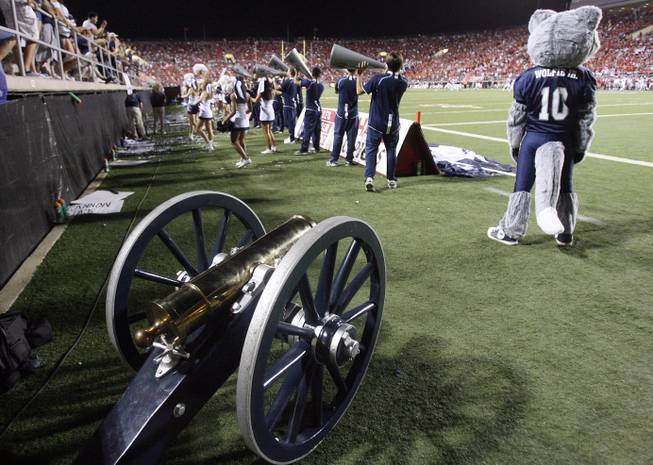
Associated Press
The Fremont Cannon sat in the corner of Sam Boyd Stadium on Oct. 2, 2010, as UNR defeated UNLV 44-26 and kept the trophy. The teams get together Saturday at noon in Las Vegas with the Rebels trying to snap a seven-game losing streak in the series.
Saturday, Oct. 13, 2012 | 2 a.m.
The UNLV Rebels and the UNR Wolf Pack will fight it out for the Fremont Cannon today in the annual "Battle for Nevada."
The Fremont Cannon is a replica of the howitzer used by pioneer John C. Fremont as he headed west on a mapping expedition into Nevada in 1843. According to the UNLV Rebels website, Fremont violated U.S. War Department rules by taking the cannon with him without permission as he blazed a trail westward, then abandoned it in a Sierra Nevada mountain snowdrift.
Following the first UNLV-UNR rivalry game in 1969, the trophy was built by the Kennecott Copper Corp., Nevada Mines Division, and is valued at more than $10,000. The 545-pound gun, which has a 55-millimeter barrel, is considered to be one of the best rivalry trophies in the country. The only other rivalry cannon goes to the winner of the Illinois vs. Purdue game.
UNLV won the 1970 game and became the first team to possess the cannon. It has since changed hands 12 times and is painted to match the color of the winning team's school.
In the beginning, it was fired by the team in possession following each touchdown. But it has been out of operation since 2000. That's because in a 2000 post-victory melee at Sam Boyd Stadium, UNLV fans tried to lift it in celebration. They succeeded, for a moment, before dropping and breaking it.
The cannon was refurbished for $1,500 by the UNLV athletics department, which decided not to fire the cannon again.
UNR, which leads the Battle for Nevada series 22-15, has held the cannon since 2005.
The trophy is among dozens of college football rivalry awards that exchange hands each year, from jugs to a 330-pound statue of a Indian chief. Below are some of them:
-
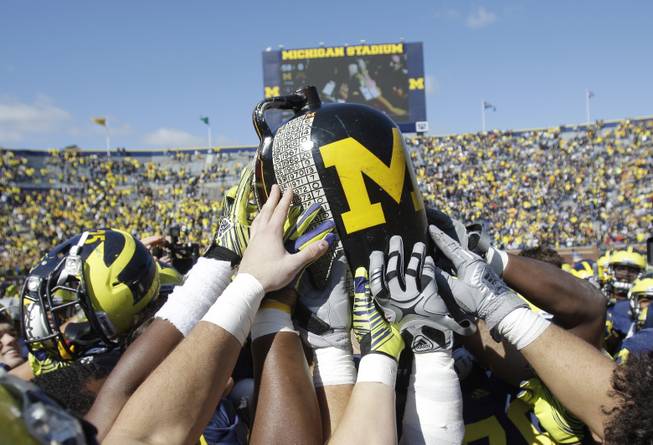
Little Brown Jug
The Little Brown Jug is an earthenware vessel awarded to the winner of the annual game between the University of Minnesota Golden Gophers and the University of Michigan Wolverines.
The trophy is technically the oldest rivalry traveling trophy in U.S. college football, created after the teams met up in 1903.
According to Wikipedia, the jug was purchased for the Michigan coach, who was afraid his visiting team's water supply might be contaminated. As the story goes, the game between the two powerhouse teams ended in a 6-6 tie and the Michigan jug was left behind. The Minnesota team saw it as a captured war prize. Later, the Michigan coach wrote to the Minnesota coach, asking for it to be returned. But the Minnesota coach wrote back, "We have your little brown jug; if you want it, you'll have to win it." That started up the rivalry series in 1909.
Michigan currently leads the series 67-22-3.
-
The Territorial Cup
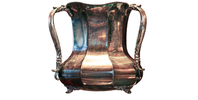
The Territorial Cup goes to the winner of the "Duel in the Desert" between the Arizona State University Sun Devils and the University of Arizona Wildcats.
The NCAA says the Territorial Cup trophy is the oldest award given for rivalry games, first won in 1899 by Arizona State. The original cup is "silverplate over a britannia base metal" and was manufactured by Reed and Barton of Tounton, Mass. The cup was actually a one-time award and didn't start traveling with the winner until 2001.
Arizona leads the rivalry series 47–37-1.
Meanwhile, a new State Farm Territorial Cup Series Trophy began in the 2009-2010 academic year, which includes head-to-head competitions in 18 different sports between the two schools. Arizona has won that trophy each year.
-
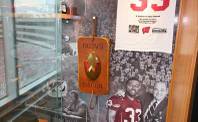
Slab of Bacon/Paul Bunyan's Ax
Slab of Bacon was the original trophy that went to the winner of the game between the Wisconsin Badgers and the Minnesota Golden Gophers.
According to Wikipedia, the trophy, created in 1930, was a piece of black walnut wood carved with a football and topped by a letter W or M, depending on which direction the slab is turned (and who holds the trophy).
In 1943, the Minnesota coach refused to accept it, saying it shouldn't be using it during World War II (bacon was rationed at the time). After that, the slab became "lost," but eventually resurfaced in 1994.
In 1948 a new trophy was created, Paul Bunyan's Ax, named after the mythical giant lumberjack Paul Bunyan. The scores of each game are recorded on the handle. The original ax was retired after the 2003 game and a new ax was created for the 2004 game.
Usually, after the winning team claims the ax at the end of the game, the team carries the ax to one of the goal posts to chop it down.
The Minnesota leads the all-time series, 59-54-8, while Wisconsin leads the Ax's series, 37-24-3.
-
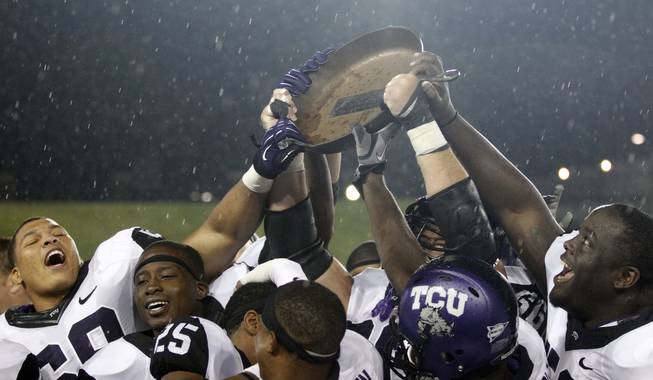
The Iron Skillet
The Iron Skillet goes to the winner of the rivalry between Texas Christian University Horned Frogs and Southern Methodist University Mustangs.
The teams have met 91 times since 1915, but the skillet didn't appear as the trophy until 1946, during a post-World War II boom in college football.
According to Wikipedia, during pre-game festivities in 1946, "an SMU fan was frying frog legs as a joke before the game. A TCU fan, seeing this desecration of the 'frog,' went over and told him that eating the frog legs was going well beyond the rivalry and that they should let the game decide who would get the skillet and the frog legs. TCU won the game, and the skillet and frog legs went to TCU. The tradition eventually spilled over into the actual game and the Iron Skillet is now passed to the winner."
Over the years, that particular skillet was eventually lost and the tradition lapsed. However, in 1993, the tradition was renewed and a new skillet was created, which is 15 1/4 inches wide, 2 1/4 inches deep and weighs about 30 pounds.
The new inscription reads, "The Battle for the Iron Skillet, SMU vs. TCU, A Tradition since 1915." TCU leads the all-time series, 45-40-7.
-
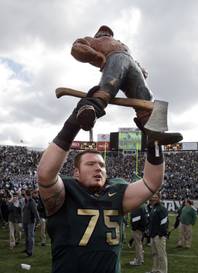
Paul Bunyan statue
A statue of Paul Bunyan is awarded to the winner of the game between the Michigan Wolverines and the Michigan State Spartans.
Michigan leads the overall rivalry series 67-35-5 since the first meeting in 1898.
The Paul Bunyan—Governor of Michigan Trophy was named to reflect Michigan's history as a lumber-producing state. First presented in 1953, the trophy is a four-foot tall Paul Bunyan who stands on a five-foot base.
-
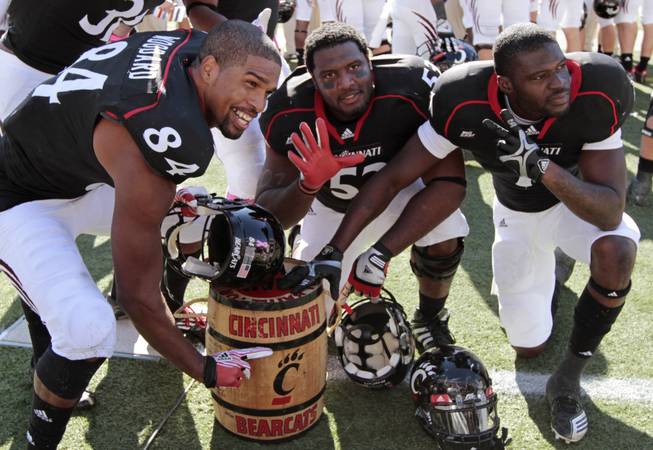
The Keg of Nails
The Keg of Nails is awarded to the winner of the football game between the University of Louisville Cardinals and the University of Cincinnati Bearcats.
The trophy is a replica of a keg used to ship nails and is thought to have been initiated by fraternity chapters on the campuses of the two schools, signifying the winners were "tough as nails," according to Wikipedia.
The current trophy keg is a replacement of the original, which was misplaced by Louisville during a period of office construction. The keg is adorned with logs from both schools and scores of the series games.
The series began in 1929, and Cincinnati leads 30-20-1.
-
The Old Mountain Jug
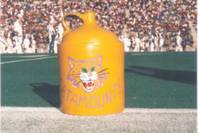
The Old Mountain Jug is awarded to the winner of the annual football game between the Appalachian State Mountaineers and the Western Carolina Catamounts.
The trophy is a gold-painted moonshine jug that has each team's mascots on opposing sides.
According to Wikipedia, the jug was donated in 1976 by Roby Triplett, manager of the Appalachian State Bookstore, whose wife, Dee Triplett, created it.
The rivalry between the two schools dates back to 1932 and the Mountaineers hold a 56-18-1 advantage over the Catamounts. The game was suspended for World War II from 1942 to 1945.
-
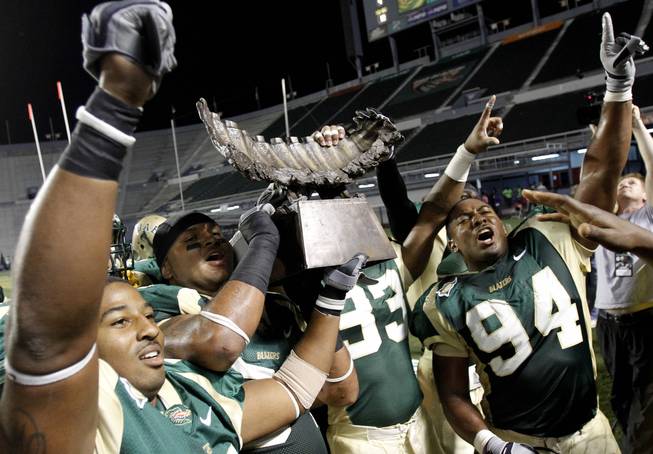
The Bones
The "Battle for the Bones" trophy, a 100-pound bronze rack of ribs, goes to the winner of the college football game between the Alabama-Birmingham Blazers and the University of Memphis Tigers.
The rivalry game, which has been held since 1997, is also accompanied by a barbecue competition.
UAB leads the series, 10-4.
-

The Jeweled Shillelagh
The Jeweled Shillelagh is awarded to the winner of the game between the Notre Dame Fighting Irish and the University of Southern California Trojans.
The Shillelagh, a ruby and emerald-encrusted Irish war club, is engraved with the words "From the Emerald Isle." It was first presented in 1952 by the Notre Dame Alumni Club of Los Angeles, according to Wikipedia.
For each USC victory, a ruby Trojan head medallion is added and for each Notre Dame win, an emerald shamrock medallion is added. Ties have both teams on the medallions.
Notre Dame leads the series 43-34-5.
-
Chief Caddo
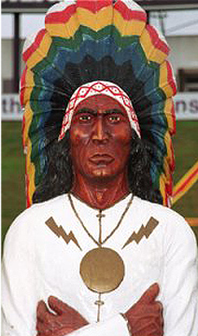
Chief Caddo is the statue given to the winner of the game between Northwestern State University of Natchitoches, La., and Stephen F. Austin State University of Nacogdoches, Texas.
According to Wikipedia, Chief Caddo stands at 7.5 feet and weights 330 pounds, making it one of the largest trophies in college football. (The Fremont Cannon weights 545 lbs.).
The statue dates to 1960, when rivals NSU and SFA decided to create the trophy based on a legendary American Indian chief whose tribe, the Caddo, settled the locations that eventually became the cities where the two universities are located.
The schools have been playing for the trophy since 1961 and NSU has a 28-14-1 lead in the series. The trophy currently resides at SFA.











Join the Discussion:
Check this out for a full explanation of our conversion to the LiveFyre commenting system and instructions on how to sign up for an account.
Full comments policy